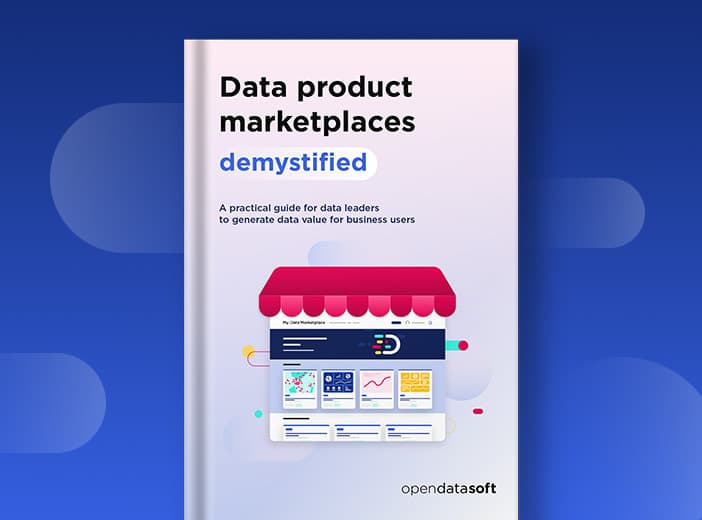Delivering long-term data product success – lessons from Gartner
How can you create and scale data product programs? Based on new insights from Gartner, we explain the key processes required in building relevant data products that meet user needs on an ongoing basis, emphasizing the importance of data product marketplaces to drive consumption and ROI.

Data products are crucial to increasing data consumption and delivering value. They improve business decision-making, increase productivity and efficiency and enable new services and revenue streams. However, many organizations are still early in their journey towards building and deploying them at scale. How can they accelerate progress and deliver sustained data product success?
Presenting at the recent Gartner Data & Analytics Summit in London, analyst Ehtisham Zaidi explained the current state of the data product market and outlined best practices to help companies successfully create scalable programs.
The business need for data products
Organizations understand the importance of data to their success, and the importance of empowering all employees with access to the right data, at the right time, and in the right format. Often the bottleneck in the process of supplying data to the business is not in its production, but instead in making it easily available and delivered to users in ways that they can easily consume.
Data products provide the answer. They are specific, actionable. continually-updated and high-value data assets that are provided in a ready-to-consume format to users, and serve a specific business need for a large group of people. They are governed by data contracts that provide service level agreements for data quality, how the product can be used, and who has access to it. All of this means they are trusted by business users, driving consumption and value. Read our blog to learn more about data products and how they differ from other data assets.
Gartner research backs up the importance of data products. 63% of respondents in the 2024 Gartner Evolution of Data Management Survey listed data products as one of the top five investment trends for data management leaders in the next 2-3 years – behind only AI and data quality/governance.
Building and deploying data products
Data products combine data, metadata, semantics and templates to provide a complete, ongoing solution for specific business use cases. Given the enormous number of ways that data can contribute to business success, it is vital that Chief Data Officers (CDOs) and other data leaders prioritize which data products they build and deploy, and create ongoing programs to produce them. This means treating them just like a physical product and understanding the market need and the return on investment to create and support them over the long-term.
Gartner recommends adopting a five stage approach to building data products:
Prework
Before beginning work, take the time to understand the scope of the product, answering questions such as:
- What problem does it solve? What is the value proposition?
- Who are the users? What are they looking for?
- How will it be supported technically?
- How will it be delivered?
Broadly, data products fit into one of three categories:
- Utility – an immediately available, accurate data product that enables employees to do their jobs more quickly and efficiently
- Enabler – a data product that supports better decision-making and potentially generates revenues or opportunities around a known, specific business outcome
- Driver – a data product that transforms the business, monetizing completely new opportunities in new areas for the business
By starting with the value proposition, accurate decisions around the data product’s structure and delivery mechanism can be made.
Plan and design
Once requirements are clear, data teams can then plan and design the product based on these needs. This includes understanding sources of data, who the data owner is, what the technical structure should be, and how it will be packaged. Clearly, involving end users during this stage of the process is vital to ensure that their needs are captured adequately.
Engineer and operationalize
Based on agreed plans and blueprints the data product can then be built. This includes mapping and testing the data flows from source systems to the product, ensuring reliability and good governance, as well as putting in place the technical infrastructure to scale usage to large groups without any impact on performance.
Package and deliver
This stage brings together all the components and data itself in a single product that is packaged to meet user needs. For example, it could be delivered as an interactive dashboard or as customer master data to ensure that it is easily consumable without requiring technical skills or support. The right delivery is a key part of driving usage. The data product has to be easily discoverable and trusted by users, with solutions such as a data product marketplace crucial to effective sharing that connects data producers and data consumers.
Monitor and observe
Data products meet an ongoing need – they are not a one-off report or project. That means that their delivery and performance need to be continually monitored and feedback collected in order to improve them to ensure they remain a close fit for user needs. Measuring performance is essential in order to demonstrate that the data product is meeting the SLAs set out in the data contract, reinforcing trust and driving usage.
The need for a long-term, lifecycle approach to data products
Gartner research shows that while data products are becoming the norm, they are not yet being deployed at scale over the long-term in the majority of organizations. For example, only half of respondents to the 2024 Gartner Evolution of Data Management Survey strongly agreed that they used DataOps within their data management organizational model, and just 43% believed that their data architecture was organized in well integrated and cohesive data ecosystems.
These findings demonstrate a requirement to scale data product creation and adopt a full lifecycle approach that makes them continually and easily available to users on an ongoing basis. It is all about meeting customer needs as they evolve and change – otherwise the risk is that usage will wither and investments will be lost.
Data products therefore need to be part of a sustained, long-term strategy that doesn’t just build products, but evaluates their success, iterates based on feedback, and improves them moving forward. There need to be clear KPIs in place around how they are built (covering time, budget and meeting requirements), how they are run (user feedback, usage and uptime), and how they are grown (speed of adding new data sources or of creating new data products). Creating and reusing templates, building cross-functional teams and federated data governance will all help scaling data product programs by combining the right skills and resources with corporate guidelines.
The importance of data product marketplaces to success
Data management is evolving quickly as data products become central to turning information into business value. This means that previous strategic approaches, which focused on technical governance, are shifting to business-driven data products and consumption-first logic.
Creating data products and ensuring that they are discovered and consumed at scale is vital. Even if they meet business needs, if consumers cannot easily find data products or trust the data within them, they simply will not be used. Traditional data catalog and governance solutions, which solely inventory data, are inadequate to meet this need.
This is why data product marketplaces are increasingly essential. They operationalize data products and ensure their consumption to drive real value. Data product marketplaces are centralized, self-service spaces that contain all of a company’s data assets, including data products. They focus on delivering an intuitive user experience, modeled on an e-commerce marketplace, making it simple for consumers to discover, trust and consume data. Features such as AI-powered search, recommendations and capabilities that directly connect users with data producers, and granular access management to deliver security and governance are vital to underpinning this experience and building user trust.
Data marketplaces provide the storefront into all of an organization’s data, allowing consumers to quickly find the relevant products they need to improve efficiency, decision-making and innovation. They enable new services and generate ROI on wider data investments, as well as providing trusted data for AI models and agents.
Picking the right data product marketplace vendor
According to Gartner, the data marketplace market is still nascent, emerging as buyers embrace data products and shift away from strategies that are focused on technical data governance. It lists a range of vendors and types across the data product ecosystem from those offering broader data management solutions to consultants and service providers. However, many existing solutions have added data products onto legacy systems, meaning they cannot deliver tailored functionality. Other new players are too narrow or service-dependent.

All of this means that when it comes to data marketplaces there is a currently high demand for expert guidance as companies focus on strategies to adopt and scale data products to drive value. First projects need to prove ROI fast in order fuel wider roll-outs, meaning that Gartner recommends working with best-of-breed players (listed in Stand-alone category above), with focused data marketplace technology and the ability to demonstrate value from a range of use cases, rather than legacy technical data governance vendors.
Best practice recommendations
So where should companies start with data products? Ehtisham Zaidi finished by sharing six best practices that underpin success, across both the short- and long-term.
Adopt a scalable approach but start small
Create a strategy that is able to scale to cover a large number of data products, but begin with smaller, focused efforts. Start with low-hanging fruit – partner with domain teams to identify well-established use cases that are broadly understood and offer clear value.
Prioritize high-impact use cases
Focus initial efforts on mission-critical business use cases that require scaling. Align these with use cases hindered by central IT bottlenecks to maximize impact and momentum.
Deliver incrementally through Minimum Viable Data Products
Emphasize the development of minimum viable data products (MVDPs) that provide immediate value and can be iteratively enhanced, rather than striving for fully refined solutions from the outset.
Align on Key Performance Indicators early
Ensure alignment between data producers and consumers on the KPIs that define success before development begins, establishing shared goals and clear expectations.
Strengthen the Data Product Manager role
Invest in the role of the data product manager. In addition to strong product management skills, they must also be able to effectively bridge business needs and technical execution for data engineering teams.
Track and promote data product success
Establish clear metrics to evaluate the performance of data products, and actively communicate their impact to secure ongoing support and investment from business stakeholders.
Industrializing the adoption of data products
Essentially, successfully scaling data product programs requires organizations to apply proven product management principles. They should start with a well-defined user need and a strong value proposition, understand the potential ROI of adoption and then create and deliver a product that closely matches consumer requirements. Data products then need to be continually monitored and assessed to ensure they continue to deliver what users want, using feedback to drive ongoing improvements. Above all, availability is key – in the same way that physical products need to be stocked in relevant stores, so data products must be accessible through a single, self-service data product marketplace to drive adoption and maximize value.



